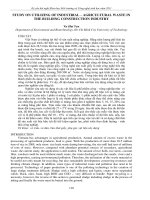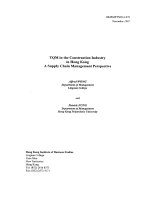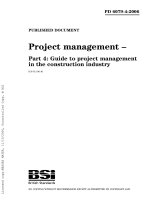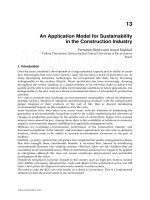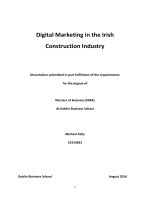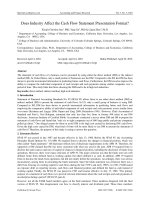Cash flow defining the construction industry
Bạn đang xem bản rút gọn của tài liệu. Xem và tải ngay bản đầy đủ của tài liệu tại đây (12.74 MB, 84 trang )
CASH FLOW DEFINING THE CONSTRUCTION INDUSTRY
A Thesis
by
SHALINI NAIR
Submitted to the Office of Graduate and Professional Studies of
Texas A&M University
in partial fulfillment of the requirements for the degree of
MASTER OF SCIENCE
Chair of Committee,
Committee Members,
John M. Nichols
Edelmiro Escamilla
Kevin T. Glowacki
Head of Department,
Joseph P. Horlen
August 2015
Major Subject: Construction Management
Copyright 2015 Shalini Nair
ABSTRACT
Cash flow is one of the most critical aspects in the proper management of any
company or industry. Success or failure in proper cash flow management ultimately
plays a huge role in determining the success or failure of the company or industry as a
whole. Cash flow exists at three levels, the company management level, at an individual
manager level and at the individual level in terms of productivity. Cash flow can be
observed as a series of transactions in a game. The interesting feature in the game is that
the state of no-move by one player, as in a failure to pay, may lead to a game-ending
move for another player. Cash flow is not like productivity, it is not completely
controlled by factors in the company’s control, and even the best-managed companies
may experience liquidity problems from time to time. This research develops the game
and the game rules to study cash flow at a microeconomic level. The game represents a
real life scenario; the decisions are taken based on input data and prior knowledge. The
game result is a cash flow model. The cash flow model provides input data for a
statistical analysis of the output data. Most cash flow decisions are made by a manager
with limited autonomy and often no real control occurs at the financial management
level. The personal responsibility levels are moderate and the returns based on the
decisions made are sometimes hard to determine. The developed game rules model such
a situation, providing a Superintendent with a scenario to control cash flow for a
theoretical site and contract. The game output will provide a data set to review the
Superintendent’s performance in managing the cash flow presented in the game. Further
research will use the game to study individual players and compare the results.
ii
DEDICATION
To my parents and brother for always believing in me and always supporting me in all
my endeavors. To my friends for always standing by me, and helping make this journey
so far in United States fruitful.
iii
ACKNOWLEDGEMENTS
I would like to thank my committee chair, Dr. Nichols, and my committee
members, Dr. Escamilla and Professor Glowacki, for their guidance and support
throughout the course of this research. I express my gratitude, as it would not have been
possible without them.
Thanks also go to my friends and colleagues and the department faculty and staff
for making my time at Texas A&M University a great experience.
Finally, thanks to my mother and father for their encouragement.
iv
NOMENCLATURE
Cash Flow
is movement of money in to or outside of the project, company or
business. A period of extended cash flow out of a project or
company can results in the need to declare bankruptcy
Net Cash Flow
is difference between a company’s cash flowing in to the project
and cash flowing out of the project in a given period, in other
terms where revenue is higher than the expenses. Three types of
cash flow exist, positive, neutral and negative. Neutral cash flow
is rarely common, but it may occur for brief periods
Positive Cash Flow
where the cash floating in is higher than the cash floating out of
the project. Positive cash flow is the preferred arrangement. Often
contract writers frustrate the development of positive cash flows
with withheld amounts
Negative Cash Flow where the cash floating out of the project is greater than cash
floating in to the project, in other terms where expenses are more
than revenues. Negative cash flow requires sufficient liquidity in
the firm to weather the negative cash flow periods
v
TABLE OF CONTENTS
Page
ABSTRACT .......................................................................................................................ii
DEDICATION ................................................................................................................. iii
ACKNOWLEDGEMENTS .............................................................................................. iv
NOMENCLATURE ........................................................................................................... v
TABLE OF CONTENTS .................................................................................................. vi
LIST OF FIGURES ........................................................................................................ viii
LIST OF TABLES ............................................................................................................. x
CHAPTER I INTRODUCTION ....................................................................................... 1
Background ................................................................................................................ 1
Problem Statement ..................................................................................................... 2
Research Objectives ................................................................................................... 2
Assumptions of the Study........................................................................................... 3
CHAPTER II LITERATURE REVIEW ........................................................................... 4
Introduction ................................................................................................................ 4
Construction ............................................................................................................... 4
Cash Flow Basics ....................................................................................................... 5
Other Factors .............................................................................................................. 8
Various Financial Factors ......................................................................................... 11
Past Studies............................................................................................................... 12
Industry Survival ...................................................................................................... 13
Various Determinants ............................................................................................... 15
Risk Factors .............................................................................................................. 21
Summary .................................................................................................................. 29
CHAPTER III GAME METHODS................................................................................. 30
Introduction .............................................................................................................. 30
Company Data .......................................................................................................... 31
vi
Building and Construction Details ........................................................................... 33
Company Accounting Rules ..................................................................................... 41
Summary .................................................................................................................. 42
CHAPTER IIII GAME DEVELOPMENT ..................................................................... 43
Study Design ............................................................................................................ 43
Game Design ............................................................................................................ 43
CHAPTER V CONCLUSIONS ...................................................................................... 46
REFERENCES ................................................................................................................. 47
APPENDIX A GAME SHEETS ...................................................................................... 54
vii
LIST OF FIGURES
Page
Figure 1. Dises House – 1921 ............................................................................................ 5
Figure 2. Company Failure Mode, from Arditi and Koksal (2000) ................................. 16
Figure 3. Survival Model, from Arditi and Koksal (2000) .............................................. 17
Figure 4. Company Income - 1994-2015 ......................................................................... 32
Figure 5. Highland Park Location (from Google Earth, 2015) ........................................ 33
Figure 6. Perspective View of the Typical Small House ................................................. 34
Figure 7. Small House Floor Plan .................................................................................... 35
Figure 8. Building used for Game Play ............................................................................ 35
Figure 9. Revit Model of the Dises House ....................................................................... 36
Figure 10. Costs for Each Item......................................................................................... 38
Figure 11. Material Purchase Delivery Time ................................................................... 40
Figure 12. Game sheet 1 - Building Permit ...................................................................... 55
Figure 13. Game sheet 2 – Impact Fee ............................................................................. 56
Figure 14. Game sheet 3 – Water and Sewer Inspection fees .......................................... 57
Figure 15. Game sheet 4 – Excavation ............................................................................. 58
Figure 16. Game sheet 5 – Foundation ............................................................................ 59
Figure 17. Game sheet 6 – Pouring Basement Walls ....................................................... 60
Figure 18. Game sheet 7 – Back Fill ................................................................................ 61
Figure 19. Game sheet 8 – Foundation Sill Plates ........................................................... 62
Figure 20. Game sheet 9 – First Floor Joists and Decking .............................................. 63
Figure 21. Game sheet 10 – First Floor Framing ............................................................. 64
viii
Figure 22. Game sheet 11 – Roof Truss Installation ........................................................ 65
Figure 23. Game sheet 12 – Exterior Sheathing and Sheetrock ....................................... 66
Figure 24. Game sheet 13 – Plumbing ............................................................................. 67
Figure 25. Game sheet 14 – Utilities ................................................................................ 68
Figure 26. Game sheet 15 – Heating, Ventilation, and Air Conditioning ........................ 69
Figure 27. Game sheet 16 – Garage Fit Out ..................................................................... 70
Figure 28. Game sheet 17 – Cabinets and Countertops ................................................... 71
Figure 29. Game sheet 18 – Interior Doors ...................................................................... 72
Figure 30. Game sheet 19 – Painting ............................................................................... 73
Figure 31. Game sheet 20 – Wood Deck or Patio ............................................................ 74
ix
LIST OF TABLES
Page
Table 1. Dises Home - First Floor Dimensions, Areas, and Volumes ............................ 36
Table 2. Cost and Construction Schedule Data ............................................................... 37
Table 3. Material Purchase Delivery Times .................................................................... 39
x
CHAPTER I
INTRODUCTION
Background
Despite the considerable amount of literature existing on the problem of company failure
due to poor management of cash flow in the construction industry and other volatile
industries, challenges on implementing efficient cash flow continue to plague the
construction industry (Birchall, 1991; Huang, 2009; Lennox, 1999; Ogawa, 2015; Wan
& Zhu, 2011). Cash flow is important in the construction industry, as it is in all
industries. Recent research at TAMU has looked at using Game Theory to study the
problems and opportunities associated with Reverse Auction Bidding (van Vleet, 2004).
This Reverse Auction Bidding research provided the conceptual idea for this study into
cash flow in the construction industry. Reverse Auction Bidding case studies using a
simple game showed the dominant influence of personality type on the returns. The
long-term goal of this research is to investigate the performance of trained construction
specialists in controlling a standard cash flow situation. The statistical properties of the
construction scientist’s performance can be measured and the factors influencing the
performance investigated in future case studies.
Cash flow control occurs at three levels, the company management team, at the
individual manager level and as a productivity measure for the individuals. Cash flow
management at the company level is a well-understood process, but at the individual
superintendent level, there is room to study the performance of individuals in making
1
decisions that affect the company cash flows. This problem is one of microeconomics
(Lennox, 1999), the cash flow must in the end be positive for job success.
The thesis provides
•
Chapter II Literature Review, where the basic problem concepts are
outlined in some detail
•
Chapter III Game Method, provides the conceptual idea for the
development of the game and game rules
•
Chapter IV Game Development, outlines a summary of the game play
and intended analysis methods
•
Chapter V Conclusions provides conclusions and recommendations for
the use of the game
•
Appendix A provides the game sheets
Problem Statement
A game is proposed and developed to measure cash flow control performance. New
knowledge will be sought in future case studies to understand how the various factors
influence each other in measuring the performance of the cash flow equation at the
lowest element for a new field superintendent.
Research Objectives
The major research objectives are:
•
Create the rules for a game that allows the study of individual performance in the
management of cash flow at the superintendent entry level in a construction
company, the new field superintendent
2
•
Outline the game development and methods
Assumptions of the Study
This study will be focused on the factors of construction Industry in United States. The
study assumptions are:
•
Limited to a simple game
•
Game play is expected to model real world scenarios
•
Limited to one player at a time
•
The players act in an honest and fair manner
3
CHAPTER II
LITERATURE REVIEW
Introduction
This literature review outlines:
•
Construction
•
Cash flow basics
•
Other factors
•
Various financial factors
•
Past research studies
•
Industry survival
•
Various determinants
•
Risk factors
Construction
Construction is the lifeblood of the economy along with agriculture. The construction
industry is one of the most significant contributors to the U.S economy and is one of the
riskiest businesses in the market (Eisdorfer, 2007; Wong & Ng, 2010). The development
of US assets ranges from the simplest house to the most complex government project
related to national security. Figure 1 shows a typical small home constructed in the
1920s on the east coast of the USA. Little has changed in the way of construction since
that time and the average home builder would be quite comfortable building this home in
the modern era, although the fittings may change and the boiler room provided could be
used for other things.
4
Figure 1. Dises House – 1921
This home represents the quintessential dream of the average US family
throughout the 20th century. It represents the major investment in their life and their hope
for the future of their children, being seen as an asset for their retirement and for the
children. The house needs to be constructed in an efficient and economical manner to
achieve two clear objectives for the two parties to the construction contract, an cost
effective and well-built house for the owner and maximized returns for the builder.
There is nothing unethical in any of these objectives and the efficient management of
cash flow is one aspect of this construction. The game is built around the construction of
such a building.
Cash Flow Basics
Only about half of startup businesses remain operational after the first four years of
operation. Although this may not always be due to cash issues, cash flow is a significant
5
problem. Eisdorfer (2007) clearly showed that questions were raised at the position of
the company in the market, once it was observed to have a cash flow problem. Cash flow
problems can be accounted for in the various reasons for failure. Problems can start from
the failure to convince creditors and possible lenders of money that this inadequacy is
only temporary and would not result in bankruptcy. Therefore, forecasting cash
requirements is essential in order to make provisions for difficult times in the future
(McCaffer & Harris, 2001). Many factors account for the discrepancies in the cash flow.
Some of different categories of failure can be broken into financial issues, supplier
problems, subcontractor issues, and communication throughout the whole project (AlIssa & Zayed, 2007). Cash flow is a communication issue; the delay to cash flow can
have a serious impact on the project and in time the reputation of the entity with the
communication problem.
The construction industry is often considered a one of a kind industry and is
unique for both small scale as well as large-scale industries, but in reality, it is a
manufacturer of unit items, and the difficulty with unit item manufacture is the failure to
learn from repeated work. Repeated work brings efficiency and improved productivity,
construction uses the concepts of subcontractor and unique suppliers to provide a small
step in the path to multiple unit manufacture, but the continual shuffling of the contract
types, players, sites and clients means that the simple learning in multiple units has to be
relearned, time after time. Figure 1 shows a house that may have been built several
hundred times in the USA in the 1920’s, but each time is likely to be the first for the
construction crew.
6
If planned properly, company profits can provide an excellent return on
investment, but this requires an effective cash flow control procedure. The company has
to fund the work for the period from start until the first payment and so:
•
assuming invoices submitted monthly at the end of the month
•
the average cost item is not billed for 15 days
•
assuming a 30-day account settlement
•
the average payment period is 45 days
•
assuming a ten percent reduction on the amount as withholding,
•
the amount settled is 90%
•
the remaining ten percent is not obtained until the end of the contract
payments.
If the company operates on a ten percent profit, then the company is in a neutral
at best cash flow from the first payments. The best method to fund this type of contract
is to delay payments to sub-contractors for as long as possible, which often leads to the
contract terms requiring settlement of all subcontractor accounts prior to invoice
settlement. This is in reality a game of cat and mouse involving the movement of money,
and it is the velocity of money that is an important indicator of economic vitality
(Ogawa, 2015).
Research shows that only ten percent of companies that earn $10 million or less
forecast their cash flow, which contributes to the excessive failure rates (Strugs, 2015).
Complexity and construction projects go hand in hand. Even the most profitable
company in the construction industry can collapse if cash flow management is not
7
effective (Central Computer and Telecommunication Agency., 1993; Liu, Zayed, & Li,
2009).
Cash flow is defined by Cooke . B. and Jepsen (1986) as the movement of money
flowing in and out of the business. Positive cash flow is the money flowing in to the
business whereas money flowing out of the business is negative cash flow. The
difference between the positive and negative cash flow is called net cash flow.
Additionally Cooke . B. and Jepsen (1986) referred positive cash flow as the money
received in the form of monthly payment whereas negative cash flow is something
money spent on materials, wages, and overheads during the course of work as shown in
the following equation:
i−o = n
Where, i , inflow cash flow, o , outflow cash flow and
(1.1)
n is the net cash flow.
Cash flow is a simple cycle and this thus amenable to study using game theory. The
interest is in maximizing the return to the builder, whilst maintaining a legal contract.
The input and output functions are time based, with a Dirichlet Delta Function form,
which is amenable to game play.
Other Factors
Many other factors can affect a company and cause issues with cash flow. These factors
include:
•
The indirect costs often exceed the direct costs (Wong & Ng, 2010) and control
over indirect costs can be difficult in a time of market volatility
8
•
More than 80% of company failures are due to budgetary and macroeconomic
issues within the construction industry (Arditi, Koksal, & Kale, 2000)
•
The construction industry is a very competitive industry, and during periods of
intense competition, control of cash flow can be critical
There is thus a need for effective management of cash flow to survive and sustain in
the end (Liu et al., 2009). One of the major problems causing failures in construction
projects is a lack of liquidity (Al-Issa & Zayed, 2007; Argenti, 1976). According to
various surveys conducted, financial and budgetary factors are the leading causes of
failures among others in the construction industry (Kivrak & Arslan, 2008).
Poor financial management, inadequate attention to cash flow management in
particular is the main reason behind why the construction industry suffers the largest
number of bankruptcy of any sector of the economy(A. Boussabaine & Kaka, 1998;
Calvert, 1986; McCaffer & Harris, 2001).
Additionally, Strugs (2015).states that for a company to succeed, clear
understanding of profit and loss is necessary whether it is in strategy, leverage or
logistics. Unfortunately, poor cash flow and ineffective management are plaguing the
construction industry. Most of the construction company failures are accounted due to
poor financial management. The major problem with this industry is that client payment
usually gets cleared in 45 days after billing, whereas vendors are required to be paid
usually within 30 days of work, whereas employees are supposed to be paid much earlier
resulting in negative cash flow. This without proper financial resources often results in
disastrous capital outflow. The secondary is that in a downturn, if the workload falls to
9
71 % of the peak workload and the average returns fall to 71% of the peak prices, then
the company has to subsist on 50% of the previous income, which requires drastic
remedial action to realign the company assets, personal and costs. One of the most
important tools in the construction industry is financial management. The construction
industry is marred by the largest rates of insolvency in the economic sector. Moreover,
an accurate cash flow prediction will help solve any unexpected financial requirements,
as decision making would become easier if we know the source of cash as well as the
structure of its flow within the company (El Din Hosny & El Beheri, 2014).
Financial planning is one of the most important necessities for a construction
industry to survive, as a lack of funds has been seen as the biggest reason for failed
projects in the past. Al-Issa and Zayed (2007) states that it is impossible for a contractor
to survive in the construction industry without proper cash flow management, as is the
case for all industries as well as individual entities.
The purpose of the capital system is to provide sufficient equity forms to a
company to allow it to commence and survive. Cash flow ensures that the capital equity
market receives sufficient returns to allow its business to borrow. Failures and defects
are considered to be a common phenomenon in the construction industry as it can impact
the cost and duration of the project considerably. If the necessary precautions are not
taken it can lead to serious problems in near future (Ahzahar, Karim, Hassan, & Eman,
2011).
10
Various Financial Factors
There are various financial performance models that can be seen in the literature to study
failures in the construction industry. Most of them use financial ratios through a
statistical search (Kangari, Farid, & Elgharib, 1992). However, it has been argued that
these financial ratios are not accurate in identifying the causes of failure and cannot be
relied upon (Argenti, 1976). The factors enumerated are:
1. Budgetary Issues
Compared to larger firms, smaller firms pay less attention to financial ratios (Storey,
1994; Storey, Keasey, Wynarczyk, & Watson, 1987). As compared to small firms,
large firms face fewer challenges with cash flow and payment issues as they have a
better chance of receiving support from financial institutions. Additionally, it has
been seen that insufficient capital, burdensome institutional debt and heavy operating
expenses besides the typical procedures of monthly payments are affecting cash flow
of a construction company by owner or contractor (Arditi et al., 2000).
2. Human/Organizational Capital Issues
According to Arditi et al. (2000) lack of commitment, managerial experience, fraud
and poor working habits amount to 7.54% of the overall failure factors. Argenti
(1976) describes a lack of managerial experience as the cause for one man rule or an
unbalanced top team, and financial functions to be weak. It is more evident in small
firms where there is a lesser scope for interaction among team members and the firm
is dominated by a chief executive or one leader. According to Adizes (1989) for
infant organizations a high level of commitment is the key to survive. Additionally
11
Adizes (1989) highlighted that young organizations will break up if they are not
more commitment focused and action oriented. It takes some measure of sound
financial and human resource planning to translate a group of people into a
construction company able to handle even moderately sized projects. The high
failure rate can be attributed to some of these factors, but essentially it is a lack of
planning and often poor communication that seals a company.
Past Studies
In mid 1980s, The Business Roundtable, an organization of large industrial construction
owners, conducted a research study for why construction costs are more than its actual
worth. Every facet, which is involved in the construction process, was critically
examined and explicit recommendations to the participants in the industry were made.
Some of the factors suggested were quality awareness, smooth labor relations, effective
project management and access to highly complex procurement systems for the
contractors to be familiar with the needed tools to survive (Business Round Table.,
1983).
A company can be pushed to a higher level of risk with financial debt because of
overexpansion that eventually increases its chances of failure. Failure can be accounted
to too many projects, which a company sometimes cannot afford either because of
employing too many people without an appropriate financial structure in place (Arditi et
al., 2000).
Three distinct control entities exist in a company. The budget developed by the
owner or developer typically in some form of a contract, the equity partners in the
12
company and the workforce of the company. The workforce has the least control of all
of the entities, except in some exceptional circumstances, such as in Germany. This in
itself is a major issue because the workforce often has a significant unseen capital
investment with the foregone wages. An employer might have worked for a week,
fortnight or month before receiving a paycheck. The company is selling the products of
the labor in that period and so can develop a cash flow. This point to some of the
injustice in the existing capitol system, which poorly defines capital and provides
excessive rewards for some forms of capitol and not others. After all the worker is
risking a wage check, a not insignificant amount of money. Construction industry is used
as a regulator of the economy by the government. A UK Government White paper by
Emerson (1962) is one of the first studies to document the consequences of this practice
by government. Such regulation can come at a price for small companies, who may not
survive an economic squeeze, as the government tries to control the entire economy.
There has been a distinct movement to a freer market since WW2.
Industry Survival
Survival of an organization is highly dependent on successfully transforming the inputs
acquired by the environment to an output. These are influenced by strategic choices
made by the organization or an individual and also on the environment and context in
which these decisions are made and implemented (Boyle & Desai, 1991). Success and
prosperity of the organization depends on the smooth flow of all the resources. This
concept eludes in part to the corporate culture, whether the company is new and growing
or old and potentially stagnant. The capital market provides mechanisms for the former
13
to be turned into the latter, as the world’s economy grows. The recent growth of Apple
provides one example of the growth potential if the cash flow is maintained and the
company mystic is embraced by world’s people, or one can be old, boring and moribund
like IBM, although one can still be profitable.
The construction industry is a fluctuating industry characterized by the constant
changes in its construction market landscape. The health of the economy and business
conditions often determine the value of these investments affecting interest rates and
growth prospects among others. Platt and Platt (1994) indicate that it is this cyclic
behavior of the economy that could cause failures in businesses. Many studies have been
conducted so far to increase productivity and performance at the company or project
level, but there is very limited data reporting on business failures in construction
industry (Koksal & Arditi, 2004). In 1997, the total value of liability failure in the
construction industry constituted about 5% of the total value of failure liabilities in the
US and amounted to approximately $2 million. Additionally the failure rate per 10,000
firms in the construction industry was 116 in 1997 (Dun & Bradstreet Corporation.,
1997). The researchers have described causes of the failure in different ways ranging
from managerial aspects to the incompetency of the CEO’s (Argenti, 1976; Storey,
1994). However, when it comes to the construction industry, failures due to
organizational and managerial aspects are barely touched upon in the research literature
(Koksal & Arditi, 2004).
14
Arditi et al. (2000) conducted a study on business failures which was based on
events which are under management control (internal factors) and which are beyond
management control (external factors), and the responses are generated by the
administrative system and strategic planning groups. Furthermore, factors like business
and market adaptation issues, organizational and financial capital factors and business
and market adaptation issues were found to be the direct driving force of failures.
Various Determinants
There are various determinants identified in the literature that can account for company
failure. Figure 2 shows company failure modes from a study by Arditi and Koksal
(2000).
15
